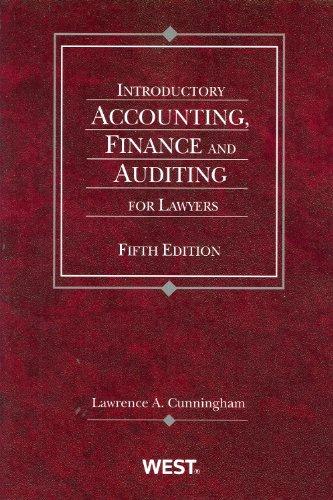Question
Emerald Ltd, a manufacturing company, commenced operations on 1 July 2016 by issuing 350 000 $5.00 shares, payable in full on application on a first-come,
Emerald Ltd, a manufacturing company, commenced operations on 1 July 2016 by issuing 350 000 $5.00 shares, payable in full on application on a first-come, first-served basis. By 31 July 2016 the shares were fully subscribed and duly allotted. There were share issue costs of $10 000. No additional shares were issued during the year ending 30 June 2017.
For the year ending 30 June 2018, the company recorded the following aggregate transactions:
|
| $ |
| Sales | 5 120 000 |
| Interest income | 34 000 |
| Sundry income | 25 000 |
| Cost of Sales | 2 465 000 |
| Employee benefit expenses | 856 000 |
| Depreciation expense | 244 000 |
| Amortisation - franchise | 25 000 |
| Rental expense | 120 000 |
| Advertising expense | 147 000 |
| Insurance expense | 48 000 |
| Freight out expense | 110 000 |
| Doubtful debts expense | 16 000 |
| Interest expense | 36 000 |
| Borrowing Costs | 9 000 |
| Other expenses | 8 000 |
| Income tax expense | 320 000 |
The following additional information was noted during the preparation of financial statements for the year ended 30 June 2018:
75 000 fully paid ordinary shares have been issued on 1 October 2017 at the price of $4.00.
$135 000 dividends (31.76 cents per share) were declared and paid during the 2018 financial year. A final dividend for 2018 of $51 850 was proposed but not recognised in the financial statements.
There was a gain of $20 000 from the cash flow hedge arrangement during the 2018 financial year. Any gain or loss associated with the cash flow hedge is directly recognised in equity. There was no previously recognised cash flow hedge reserve before the 2018 financial year.
$25 000 of bank loans is repayable within 1 year.
$90 000 of other loans is repayable within 1 year.
The employee benefits of $32 000 are expected to be settled wholly within 12 months.
Emerald Ltd measures inventory at the lower of cost and net realizable value and property, plant and equipment using a cost model.
The summarised balances are provided below:
| Year-end balances, 30 June 2018 | $ |
| Cash on hand | 960 000 |
| Cash on deposit, at call | 82 000 |
| Accounts Receivables | 665 000 |
| Allowance for doubtful debts/ Impairments | 24 000 |
| Other debtors | 27 000 |
| Finished goods inventories, 30 June 2018 | 600 000 |
| Work in Progress inventories 30 June 2018 | 105 000 |
| Land | 94 000 |
| Buildings | 230 000 |
| Accumulated depreciation buildings | 60 000 |
| Plant and equipment | 1 385 000 |
| Accumulated depreciation plant and equipment | 330 000 |
| Franchises | 140 000 |
| Accumulated amortisation of franchise | 50 000 |
| Goodwill | 620 000 |
| Bank loans | 92 000 |
| Other loans | 440 000 |
| Accounts payable | 696 000 |
| Provision for employee benefits | 116 000 |
| Income tax payable | 35 000 |
| Deferred tax liability | 140 000 |
| Retained earnings, 30 June 2017 | 225 000 |
| Dividends paid | 135 000 |
| Cash flow hedge reserve (equity) | 20 000 |
Required:
For the year ending 30 June, 2018,
Using the pro forma table supplied in appendix B, prepare a preliminary trial balance for Emerald Ltd; (5 Marks)
Prepare a statement of profit or loss and comprehensive income for Emerald Ltd in accordance with the requirements of AASB 101. Emerald Ltd uses the single statement format for the statement of comprehensive income and classifies expenses by function within the statement; (18 marks)
Prepare a statement of changes in equity for Emerald Ltd in accordance with the requirements of AASB 101; (15 marks)
Prepare a statement of financial position for Emerald Ltd in accordance with AASB 101. Use the current/non-current presentation format; (17 marks)
Prepare appropriate notes to the accounts. (You do not need to prepare notes related to income taxes. Include the following note as note 1. You may optionally add accounting policies to this note): (25 marks).
1. Summary of significant accounting policies
Basis of accounting
The financial report is a general purpose financial report which has been prepared on the historical cost basis, except where stated otherwise.
Statement of Compliance
The financial statements have been prepared in accordance with the requirements of the Corporations Act, Australian Accounting Standards which include Australian equivalents to International Financial Reporting Standards (AIFRSs) and AASB Interpretations. Compliance with AIFRSs ensures the financial statements and notes comply with International Financial Reporting Standards
Step by Step Solution
There are 3 Steps involved in it
Step: 1

Get Instant Access to Expert-Tailored Solutions
See step-by-step solutions with expert insights and AI powered tools for academic success
Step: 2

Step: 3

Ace Your Homework with AI
Get the answers you need in no time with our AI-driven, step-by-step assistance
Get Started


